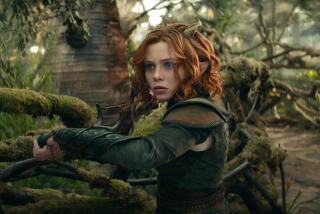There be dragons: ‘Of Dice and Men’ explores the story of D&D
- Share via
In the early 1970s, three guys in the Midwest invented a genuinely new kind of game. David Wesely, Gary Gygax and Dave Arneson were all fascinated by complicated tabletop war simulations; Wesely was the one who revolutionized game-play when he asked players in a military game to each act out the role of a single character and found himself improvising rules when the characters deviated from what he’d had in mind. Arneson picked up Wesely’s “role-playing” idea and constructed a medieval fantasy setting for it. Gygax, meanwhile, invented a game called Chainmail, with rules for determining the outcomes of medieval combat by rolling dice.
When Arneson and Gygax joined forces, they devised “Dungeons & Dragons,” first published in early 1974. The rules in the three booklets that made up the game’s first edition were badly written, confusing and amateurishly illustrated. It didn’t matter. “D&D” (as everyone calls it) was a work of genius, a game that’s really a framework for collective, improvisational storytelling. The huge role-playing game (RPG) subculture is balanced on its three basic innovations: a “dungeon master” devises a setting and a scenario and serves as referee, the other players create characters with minutely defined traits and abilities and play as those characters, and situations with multiple possible outcomes are resolved by rolling dice.
“D&D” still has something of a reputation as a ridiculous power fantasy for obsessive social outcasts, but the geeky fascinations that coalesced around it now rule mainstream pop culture. As Forbes senior editor David M. Ewalt’s “Of Dice and Men” points out, “D&D” had such a dramatic impact that the game’s formal trappings have shaped decades’ worth of storytelling outside the gaming world. (It’s impossible to imagine TV shows such as “Adventure Time” or “Game of Thrones” without “D&D,” for instance.)
His history of the game and its culture, though, never quite settles on what story it wants to tell: It’s half an attempt to explain “Dungeons and Dragons” to the uninitiated, half a collection of personal anecdotes and minutiae for devotees.
The behind-the-scenes story of “D&D’s” creators (and their various squabbles and lawsuits), and the way Gygax’s company TSR grew at an incredible rate until it collapsed, is the broadest thread in “Of Dice and Men.” That’s a compelling narrative, although Ewalt started his research a few years too late to get the perspective of the game’s originators: Gygax died in 2008, Arneson in 2009. He occasionally skimps on potentially juicy details too, such as when he notes that one early gamer (who inspired the monster called the “Egg of Coot”) didn’t like Arneson’s proto-”D&D” fantasy Blackmoor, “insulted the game and its players, and even played a nasty practical joke on Arneson.” Readers have apparently failed our saving throw to find out his name or what the joke was.
The evolution of the game itself is one of the most curious things about “D&D.” Unlike, say, “Monopoly” or “Scrabble,” it’s had its volumes’ worth of rules overhauled repeatedly over the years, and groups who want to play together have to settle on which version of the rules they’re using; “grognards,” as longtime gamers are known, often prefer older editions.
But why the changes, and why the resistance to them? Ewalt only touches on possible answers amid a stream of joking digressions and footnoted quotes from an old Monster Manual. There’s also not much here on “D&D’s” audience; the people who play RPGs and the way their players experience them, have changed drastically in the past four decades, but aside from observing that there are a lot more women playing them now than there used to be, Ewalt is more concerned with his own history as a gamer.
And there lurks the ultimate adversary within “Of Dice and Men”: a malicious voice whispering that reported books also have to be memoirs of personal transformation. When Ewalt wanders away from the historical narrative to detail some dramatic turning point in a game he’s played (from the perspective of his character), the book’s momentum slows; when he cringingly jokes about how nerdy he is, it stops altogether. And when he emphasizes that an “adventure weekend” called Otherworld that he attends isn’t really a LARP, or live-action role-playing game — “something I’d grown to fear and revile” — it’s a genuine narcissism-of-small-differences problem.
Part of the beauty of “D&D” is that it allows its players to cast themselves as heroes, within a group of peers that honors that fantasy. Ewalt tries to frame his own experience the same way, but his heroic journey here largely consists of growing interested in “D&D” again after a few decades off, getting to beta-test a new edition of the game at the very table where Dave Arneson ran the first-ever fantasy role-playing game, and finally devising a “D&D” campaign of his own. That’s fun at times for the sort of reader who can explain the difference between a cleric and a druid, but it’s hardly the stuff of legend.
Wolk is the author of “Reading Comics: How Graphic Novels Work and What They Mean.”
Of Dice and Men
The Story of Dungeons & Dragons and the People Who Play It
David M. Ewalt
Scribner: 288 pp., $26
More to Read
Sign up for our Book Club newsletter
Get the latest news, events and more from the Los Angeles Times Book Club, and help us get L.A. reading and talking.
You may occasionally receive promotional content from the Los Angeles Times.








